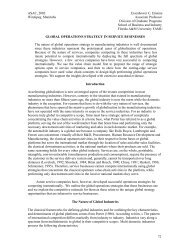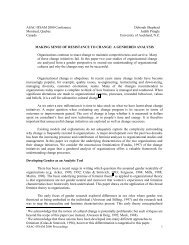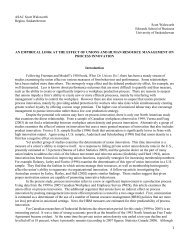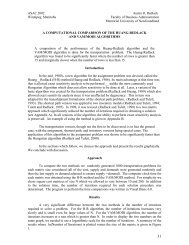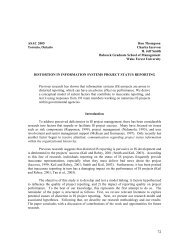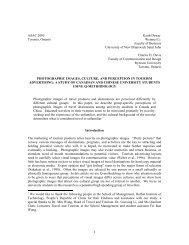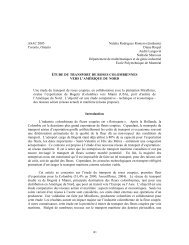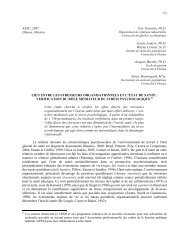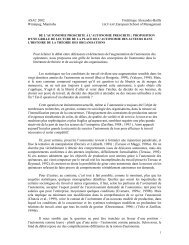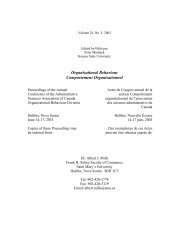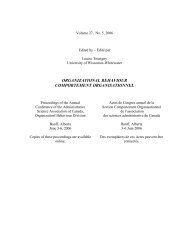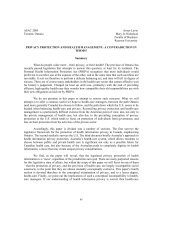104 TOTAL REWARDS FOR TECHNICAL WORKERS
104 TOTAL REWARDS FOR TECHNICAL WORKERS
104 TOTAL REWARDS FOR TECHNICAL WORKERS
Create successful ePaper yourself
Turn your PDF publications into a flip-book with our unique Google optimized e-Paper software.
Total Rewards is a promising approach to employee rewards that has recently emerged<br />
from human resource management practice (Fischer, Gross and Friedman, 2003; Gross and<br />
Friedman, 2004; Kantor and Kao, 2004; Lyons and Ben-Ora, 2002; O’Malley and Dolmat-<br />
Connell, 2003; O’Neal, 1998; Petruniak and Saulnier, 2003; Pfau and Kay, 2002; Platt, 2000;<br />
Poster and Scanella, 2001; Thanasse, 2003; Watson, 2003; Zingheim and Schuster, 2001). It is an<br />
approach to rewards management which attempts a comprehensive inclusion of all the rewards<br />
people receive in the workplace. It embraces the “complete employee value proposition”;<br />
including financial rewards such as pay, stock options and benefits; and non-financial rewards<br />
such as training opportunities, interesting work, and support for work/life integration. Total<br />
Rewards has promise for the management of technical people as demonstrated by its application<br />
at IBM (Platt, 2000), Ethicon (Thanasse, 2003) and AstraZeneca (AstraZeneca, 2004). However,<br />
there has been no systematic consideration of Total Rewards in the R&D management literature.<br />
Currently, most thinking about rewards confines itself to “compensation”, which focuses<br />
almost entirely on pay and benefits as the principal rewards an organization can offer workers.<br />
Total Rewards goes beyond that and considers a wide array of other positive results of working<br />
(intrinsic and extrinsic) such as the social stimulation which people receive at work, the<br />
satisfaction they receive from doing their jobs well and the opportunity for learning and<br />
advancement at work. The assumption is that by thinking about rewards in this broader way we<br />
will understand them all, and their relationships to each other, in a more effective way, and this<br />
will lead to more effectively managed organizations. If the full spectrum of rewards and their<br />
real value to employees can be identified, optimal mixes of rewards for those employees can be<br />
designed and offered. For example, in some circumstances spending X dollars to increase<br />
employees’ pay may not be as effective an alternative as investing the X dollars in a much more<br />
effective career progression program that gives workers a strong sense that they are growing and<br />
developing in the organization and that they have a bright future there. Under the Total Rewards<br />
framework we thus can envision trading off pay against career growth opportunities. This tradeoff<br />
might not have been thought of if pay were considered a reward and career growth a part of<br />
training. Total Rewards thus promises to overcome some of the sticking points that are created<br />
by the current set of silos used in human resource management practice.<br />
O’Neal (1998) and Kantor and Kao (2004) divide Total Rewards into four categories as<br />
shown in Table 1. For efficiency of presentation we will use this widely accepted four category<br />
model in this paper. From this we can see the comprehensive nature of Total Rewards.<br />
Proponents of Total Rewards emphasize its value for attracting and retaining workers. If<br />
the full spectrum of rewards offered by an organization is presented to recruits in a structured<br />
way, the organization will be more attractive than will firms which emphasize only pay and<br />
benefits. If the current employees of a firm are kept apprised of the complete set of rewards they<br />
are currently receiving, they will be less likely to find other firms to be attractive alternatives. It<br />
is important to effectively communicate to employees all the rewards they receive from their<br />
work as this cultivates the sense that this set of rewards is not available elsewhere and that this<br />
firm is an “employer of choice”.<br />
Medcof_ASAC2005<br />
105



